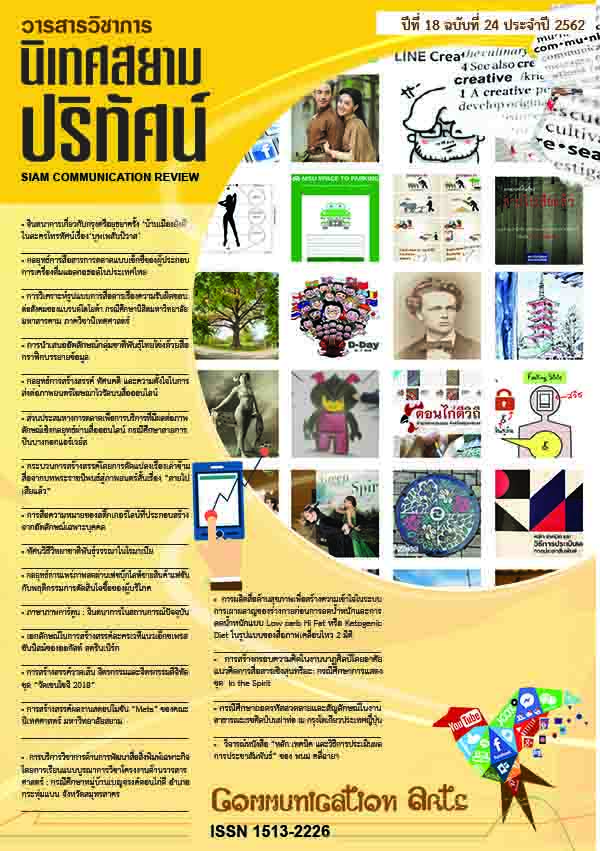Transmedia Adaptation Creative Process from Royal Literary Work to Short Film “Too Late” (Sai Pai Sia Laew)
Main Article Content
Abstract
This research aimed at studying the creative process applying the transmedia adaptation approach from print media to short film “Too late” (Sai Pai Sia Laew) Qualitative research approach was applied based on the data of creative works action collected from production crews’ depth interviews, an analysis of production reports and behind the scenes video clip and evaluation of audiences’ opinions towards the film after watching the whole film. Results indicated that the creation process of “Too late” short film started from design conception which is “Penitence”. Once getting the main concept of the story then the next step was design visualization that is script development then continued to design development which is the production design including the preproduction process which consisted of casting, location sculpting and budgeting. After that it was ready to shoot the film. Once the shooting was finished, the file was sent to the lab for visual and sound editing. This process was design refinement. On this stage, the film was finished and ready for presentation and evaluation. The evaluation technique for this research was to explore the audiences’ opinions toward the short film after viewing the whole film. Samples thought this story is suitable, good and worth to produce as short film and the content made them afraid of the drug dangers. Short film “Sai Pai Sia Laew” is Her Royal Highness Princess Maha Chakri Sirindhorn’s work which was written in 1972, when adapting to short film, there needs to be some adaptations. This is to comply with current social context and can facilitate audiences’ understandings. The adaptation was just some little changes in time and space dimension not the main concept and storyline which is invaluable imagination of the writer. The main purpose for this adaptation is to transmit imagination from written media to audiovisual media. It is required to respect the imagination of original writer. The main fact and idea should not be distorted. What can be adapt is social context to fit with the time and space of film distribution and audiences, also the film production crew should concern about the visualization to transform the imagination in the written media to present in the film and to make audiences believe in the content.
Article Details
References
คณะศิลปกรรมการผลิตสื่อ สถาบันกันตนา. (2559). เบื้องหลังภาพยนตร์ “สายไปเสียแล้ว” [วีดิทัศน์]. นครปฐม: สถาบันกันตนา
คณะศิลปกรรมการผลิตสื่อ สถาบันกันตนา. (2559). สรุปผลการดำเนินโครงการผลิตภาพยนตร์สั้นเฉลิมพระเกียรติ สมเด็จพระเทพรัตนราชสุดาฯ สยามบรมราชกุมารี เรื่อง สายไปเสียแล้ว. นครปฐม: สถาบันกันตนา.
ถิรนันท์ อนวัชศิริวงศ์ และคณะ. (2543). นิเทศศาสตร์กับเรื่องเล่าและการเล่าเรื่อง. กรุงเทพมหานคร: โครงการสื่อสันติภาพ คณะนิเทศศาสตร์ จุฬาลงกรณ์มหาวิทยาลัย.
ธาม เชื้อสถาปนศิริ. (2558). เล่าเรื่องข้ามสื่อ. วารสารนิเทศศาสตร์และนวัตกรรม นิด้า, 2(1), 59-88.
ปรีชา เถาทอง. (2557). แนวทางการวิจัยและพัฒนาองค์ความรู้ด้านการสร้างสรรค์ศิลปะวิชาการ. วารสารสมาคมนักวิจัย, 19(2), 5-11.
วิชยุตม์ ปูชิตากร. (2556). สัมพันธบทข้ามสื่อและข้ามวัฒนธรรมเรื่อง “ริง” ในนวนิยาย ภาพยนตร์ ละคร โทรทัศน์ และหนังสือการ์ตูน. วิทยานิพนธ์ปริญญานิเทศศาสตรมหาบัณฑิต, จุฬาลงกรณ์มหาวิทยาลัย.
สุรพล วิรุฬห์รักษ์. (2559). การวิจัยศิลปกรรมศาสตร์. รายงานการประชุม การประชุมวิชาการงานวิจัยนาฏกรรมแนวสร้างสรรค์. กรุงเทพฯ: สำนักงานคณะกรรมการวิจัยแห่งชาติ.
ภาษาอังกฤษ
Cleve, B. (2006). Film production management (3rd ed.). Amsterdam: Elsevier/Focal Press.
Dicieanu, M. (2013). Adaptations: Primitive Transmedia Narratives? In Crossing Channels, Crossing Realms: Immersive Worlds and Transmedia Narratives, ed. Natalie Krikowa and Shawn Edrei (e-book). Oxford: Inter-Disciplinary Press.
ออนไลน์
Jenkins, H. (2017). Adaptation, Extension, Transmedia. Literature/Film Quarterly, 45(2). Retrieved from http://www.salisbury.edu/lfq/_issues/first/adaptation_extension_transmedia.html
. (2007). Transmedia Storytelling 101. Retrieved from http://henryjenkins.org/2007/03/transmedia_storytelling_101.html.
Tripp, D. (2005). Action research: a methodological approach. Retrieved from http://www.scielo.br/pdf/ep/v31n3/en_a09v31n3.pdf


